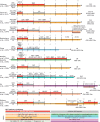Harnessing developmental cues for cardiomyocyte production
- PMID: 37560977
- PMCID: PMC10445742
- DOI: 10.1242/dev.201483
Harnessing developmental cues for cardiomyocyte production
Abstract
Developmental research has attempted to untangle the exact signals that control heart growth and size, with knockout studies in mice identifying pivotal roles for Wnt and Hippo signaling during embryonic and fetal heart growth. Despite this improved understanding, no clinically relevant therapies are yet available to compensate for the loss of functional adult myocardium and the absence of mature cardiomyocyte renewal that underlies cardiomyopathies of multiple origins. It remains of great interest to understand which mechanisms are responsible for the decline in proliferation in adult hearts and to elucidate new strategies for the stimulation of cardiac regeneration. Multiple signaling pathways have been identified that regulate the proliferation of cardiomyocytes in the embryonic heart and appear to be upregulated in postnatal injured hearts. In this Review, we highlight the interaction of signaling pathways in heart development and discuss how this knowledge has been translated into current technologies for cardiomyocyte production.
Keywords: Cardiomyocyte production; Cardiomyocyte proliferation; Cardiomyocyte self-renewal; Embryonic growth pathways; Fetal gene program; Heart regeneration; Hippo signaling; Wnt signaling; hiPSC-CM.
© 2023. Published by The Company of Biologists Ltd.
Conflict of interest statement
Competing interests J.W.B. and S.M.W. hold a patent on the expansion of hiPSC-derived cardiomyocytes.
Figures




Similar articles
-
Hippo signaling impedes adult heart regeneration.Development. 2013 Dec;140(23):4683-90. doi: 10.1242/dev.102798. Development. 2013. PMID: 24255096 Free PMC article.
-
The cell-autonomous and non-cell-autonomous roles of the Hippo pathway in heart regeneration.J Mol Cell Cardiol. 2022 Jul;168:98-106. doi: 10.1016/j.yjmcc.2022.04.018. Epub 2022 May 5. J Mol Cell Cardiol. 2022. PMID: 35526477 Free PMC article. Review.
-
Upstream regulation of the Hippo-Yap pathway in cardiomyocyte regeneration.Semin Cell Dev Biol. 2020 Apr;100:11-19. doi: 10.1016/j.semcdb.2019.09.004. Epub 2019 Oct 9. Semin Cell Dev Biol. 2020. PMID: 31606277 Free PMC article. Review.
-
mir-17-92 cluster is required for and sufficient to induce cardiomyocyte proliferation in postnatal and adult hearts.Circ Res. 2013 Jun 7;112(12):1557-66. doi: 10.1161/CIRCRESAHA.112.300658. Epub 2013 Apr 10. Circ Res. 2013. PMID: 23575307 Free PMC article.
-
A microRNA-Hippo pathway that promotes cardiomyocyte proliferation and cardiac regeneration in mice.Sci Transl Med. 2015 Mar 18;7(279):279ra38. doi: 10.1126/scitranslmed.3010841. Sci Transl Med. 2015. PMID: 25787764 Free PMC article.
Cited by
-
In Vitro Models of Cardiovascular Disease: Embryoid Bodies, Organoids and Everything in Between.Biomedicines. 2024 Nov 27;12(12):2714. doi: 10.3390/biomedicines12122714. Biomedicines. 2024. PMID: 39767621 Free PMC article. Review.
-
In-Depth Genomic Analysis: The New Challenge in Congenital Heart Disease.Int J Mol Sci. 2024 Feb 1;25(3):1734. doi: 10.3390/ijms25031734. Int J Mol Sci. 2024. PMID: 38339013 Free PMC article. Review.
-
Epigenetic Regulation of Mammalian Cardiomyocyte Development.Epigenomes. 2024 Jun 29;8(3):25. doi: 10.3390/epigenomes8030025. Epigenomes. 2024. PMID: 39051183 Free PMC article. Review.
References
-
- Abecasis, B., Aguiar, T., Arnault, É., Costa, R., Gomes-Alves, P., Aspegren, A., Serra, M. and Alves, P. M. (2017). Expansion of 3D human induced pluripotent stem cell aggregates in bioreactors: bioprocess intensification and scaling-up approaches. J. Biotechnol. 246, 81-93. 10.1016/j.jbiotec.2017.01.004 - DOI - PubMed
-
- Alam, P., Haile, B., Arif, M., Pandey, R., Rokvic, M., Nieman, M., Maliken, B. D., Paul, A., Wang, Y. G., Sadayappan, S.et al. (2019). Inhibition of senescence-associated genes Rb1 and Meis2 in adult cardiomyocytes results in cell cycle reentry and cardiac repair post-myocardial infarction. J. Am. Heart Assoc. 8, e012089. 10.1161/JAHA.119.012089 - DOI - PMC - PubMed
Publication types
MeSH terms
Grants and funding
LinkOut - more resources
Full Text Sources

